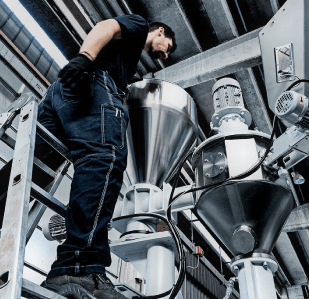Brief summary
The world of PVC pipe manufacturing involves a series of processes and technologies that come together to create one of the most versatile and widely used materials in modern engineering. In this article we take an in-depth look at the manufacturing process of PVC pipes, paying particular attention to the key extrusion process.
Production process: how does it work?
Before diving into the extrusion process, it’s important we understand what PVC is and why it is so widely used in modern industry. PVC, or polyvinyl chloride, is a thermoplastic polymer that offers a unique combination of resistance, durability, and versatility. These properties make it a first-choice material for a wide range of applications, including the production of pipes.
The cornerstone of the manufacturing of PVC pipes is extrusion. The extrusion process involves the use of specialist machines known as extruders. Extruders are designed to shape the molten PVC into a variety of forms, including pipes.
Let’s look at the four fundamental phases of the PVC pipe manufacturing process:
1) Preparing the PVC: the process begins with preparing the PVC in powder form. These raw materials are carefully chosen based on the specifics of the end product. The quality and composition of the PVC directly influence the characteristics of the resulting pipe.
2) Feeding into the extruder: once the material has been prepared, the PVC is fed into the extruder. This is a key step in which the PVC is heated to high temperatures so that it reaches a plastic state. During this process, additives can be introduced to give the material specific properties, such as resistance to atmospheric agents or colors.
3) Extrusion of the pipe: with the molten PVC ready to be shaped, the pipe extrusion process begins. The extruders are fitted with special extrusion heads that give the molten material the desired shape. The extrusion pressure and speed are carefully controlled to guarantee accuracy and consistency in the dimensions of the pipe.
4) Cooling and cutting: once the pipe has been shaped it is vital that it is cooled down quickly to keep its shape. This happens through a cooling system. Once cool, the pipe is cut to the desired length, ready for the next stage of the manufacturing process.
Manufacturing PVC pipes through the extrusion process offers numerous benefits. Firstly, the versatility of the PVC makes it possible to create pipes with a huge range of different dimensions and shapes, suitable for many different applications. The durability of the PVC also makes it ideal for outdoor settings and resistant to chemical agents, guaranteeing a long life for the end product.
Transform your production: choose excellence
Make your PVC pipe manufacturing more successful with our advanced extrusion lines. Invest in a perfect operation and superior quality. Enhance your manufacturing pathways with our cutting-edge technology and attention to energy sustainability.
Achieve excellence with Bausano and invest in operational perfection. Contact us today so we can assess – together – how to get the full potential out of your production, tailor making solutions to suit your needs. Trust Bausano to help secure your first-class pipe production future.







